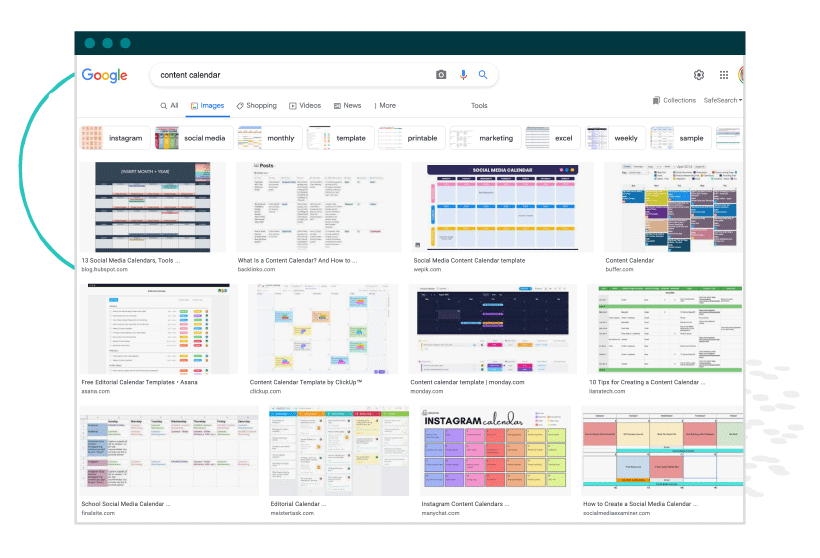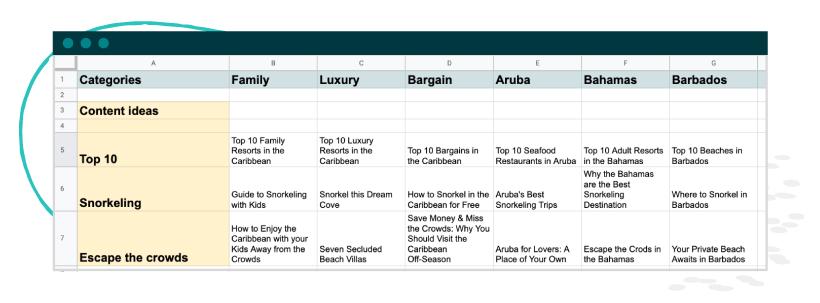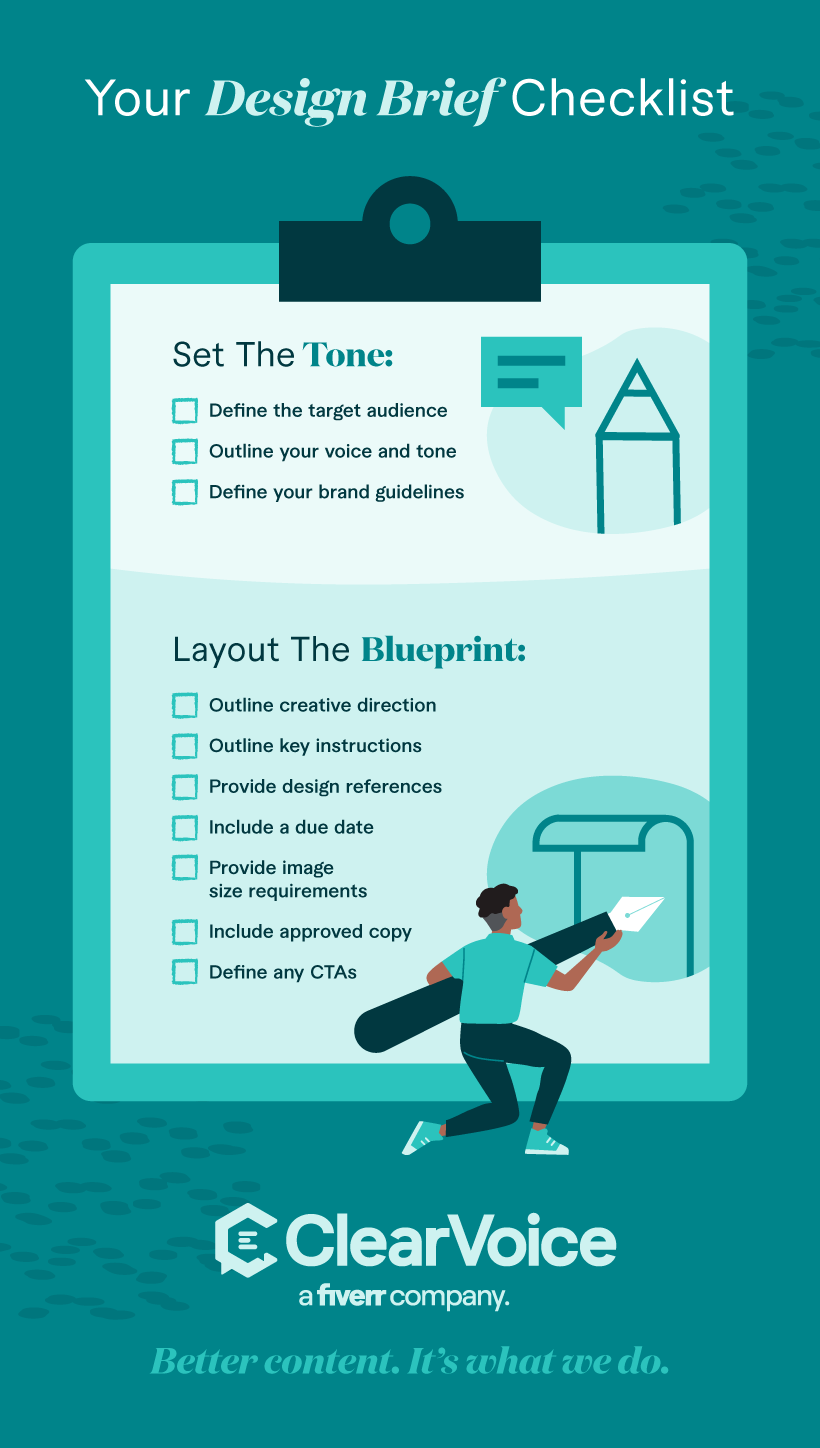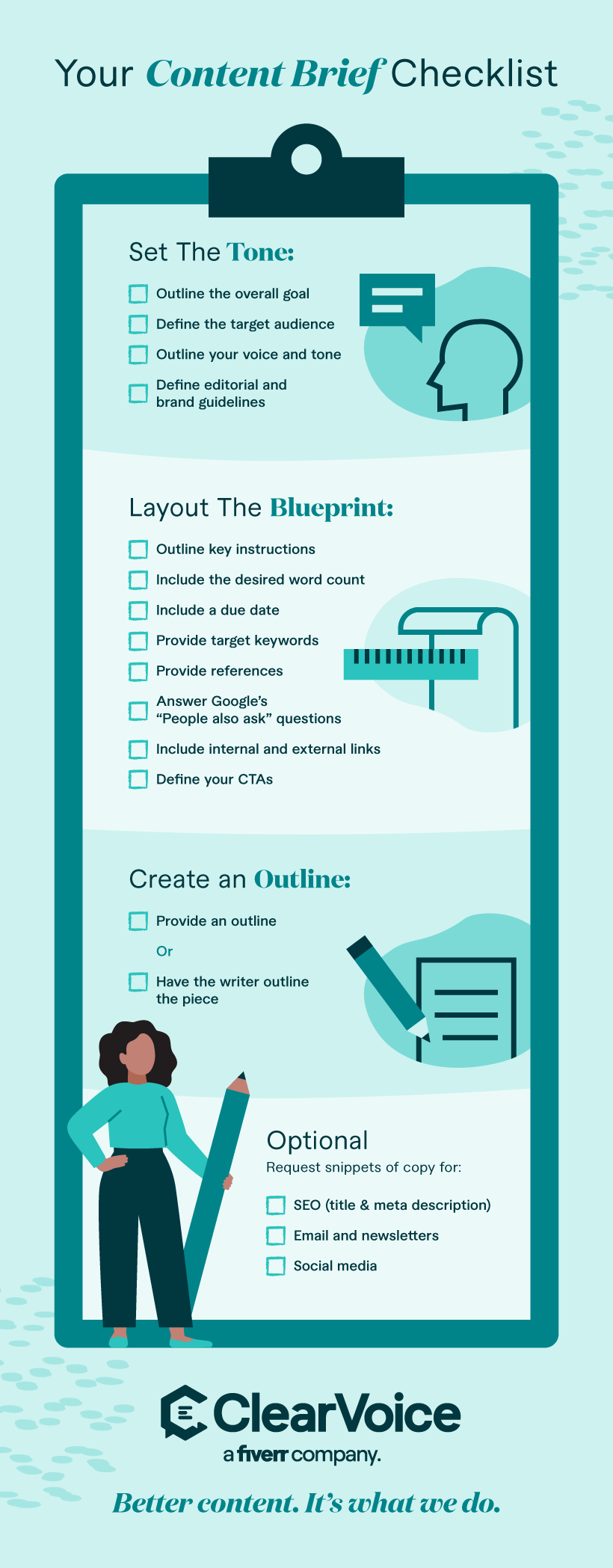Not sure how to create a content calendar or why you should?
As a content marketer, you must maintain a steady stream of fresh, reliable content targeted to your audience at each point of the buyer’s journey.
The greatest challenge is keeping your content production process as organized as possible. It’s essential to ensure that content continues to arrive on time and within your budget.
But how do you do that? The answer is simple — you create a content calendar.
Your content calendar provides a single source of data that governs every aspect of the content production, publication, and promotion process.
If used consistently, it can help you address many problems with your content marketing. A working content calendar becomes your content bible, the same way long-running TV shows develop show bibles to track all the data points for each episode.
A workable content calendar (sometimes called an “editorial calendar”) can take any one of a number of forms. Examples range from simple lists in a document to complex databases or spreadsheets.
The process of creating one can be overwhelming. That’s especially true if you’re managing a team of a few freelancers or in-house content writers.
The bigger your team, the more complex your calendar can get. So how can you create a workable process to track your team’s content production efforts without getting overwhelmed?
Learn how to create a content calendar below, the different types of calendars and their uses, best practices, and more.
What is a content calendar?
A content calendar is a document (virtual or physical) that details the planned release dates and topics for all of the content your team creates, including blog posts, social media updates, infographics, ebooks, and more.
The best content calendars also include information about the format of each piece of content (e.g., blog post, video, infographic) as well as data points such as word count, target keywords, and proposed publication date.
In short: A content calendar is an essential part of your content strategy that ensures your team is always on the same page about what needs to be created when it should go live, and who’s responsible for each piece.
Creating a content calendar will keep your process moving forward and avoid the gridlock that often occurs when multiple people are involved in content creation.
Types of Content Calendars
Before we can teach you how to create a content calendar, you’ll want to decide on the type that’s right for you. Not all content calendars are created equal. The type of calendar you need depends on several factors, including the size and structure of your team, your content workflow, and the types of content you create.
Here are a few of the most common content calendar types:
- Editorial calendar: This type of calendar is designed for editorial teams working on long-form content such as blog posts, whitepapers, and ebooks. In addition to planned publish dates, an editorial calendar tracks topics, word counts, target keywords, and other data points specific to each piece of content.
- Social media calendar: A social media calendar is similar to an editorial calendar but focuses on social media updates, including the text, images, links, and hashtags for each post.
- Video production calendar: If your team creates a lot of video content, you may want to consider using a dedicated video production calendar. This type of calendar can help you track everything from storyboards and scripts to the actual filming and post-production process.
- Marketing campaign calendar: A marketing campaign calendar is designed to track all of the moving parts of a marketing campaign, including content, social media, email, paid advertising, and more. This type of calendar is beneficial for teams that are working on multiple marketing initiatives at the same time.
Of course, you can combine different types of calendars to create a custom solution that works for your specific needs.
For example, you could make an editorial calendar for your blog posts and a separate social media calendar for your social media updates. Or you could combine both into a single content calendar.
A combined calendar might make sense for your company if there’s a lot of overlap in the content (blog posts being published, then shared on social media) and the same team members perform both functions.
Do you need a content calendar?
Let’s say you consider yourself to be an organized kind of person. You’ve got a task app, a paper-and-pen system for brainstorming, Google Docs, and searchable email — do you really need a formal content calendar?
Well, maybe not. If you’re a team of one and the only person producing a small amount of content (a few posts a month), a full-fledged content calendar might not be necessary.
However, a simplified format might provide just the boost you need to take your content marketing to the next level.
Here are just a few reasons why:
1. It encourages a more consistent production schedule and helps prevent gaps in content
Prevailing content marketing best practices include a consistent publishing schedule. Yet, one of the biggest challenges for content creators and publishers is maintaining that frequency. It’s all too easy to fall into long gaps of brand silence.
A content calendar helps you avoid that by establishing a realistic schedule that keeps your team on track.
2. It organizes your ideas and the pieces you’re working on to ensure the content gets published at the right frequency and in the correct order
Apart from the best practice of a consistent publishing schedule is the strategy of what kind of content gets published and when.
You need content that addresses each customer persona at each point along their path to a completed purchase.
A calendar helps ensure that you’re publishing an optimal mix of articles, social media posts, podcast episodes, and other kinds of content for every segment of your audience.
3. It keeps you focused on strategy and on your goal of converting readers into paying customers
You’re no longer just pushing out well-written pieces into the ether, hoping for something good to happen.
Instead, you can focus on a conversion strategy and ensure your content effectively executes that strategy. It also helps you manage your SEO and SEM strategies more efficiently.
4. It helps team members collaborate on your content production plans
One of the best parts about working with a strong team of creatives is that collaborative power can exponentially improve your content’s performance.
Maintaining and sharing a long-term content calendar enables every team member to participate in the planning, development, and production process in a targeted way.
5. It frees up time for higher-level thinking and creativity
The bottom line is that anything you do to wrangle your diverse tasks into a manageable process will free up more time for the more creative work on your list.
An organized calendar means you can move through the preliminaries more quickly and get to the deep work of crafting good content.
So, how do you get started building a content calendar?
Start With Your Goals
As you can see, a content calendar can organize ideas and workflow, make it easier to build a well-rounded body of content, keep you focused on strategy, and help everyone collaborate.
Since it serves so many functions, it’s a good idea to be sure you and your team are on the same page regarding the parameters of your content calendar before you start organizing one. You’ll want to start with:
- Workflow: Are you hoping to merely document an existing workflow or create a more streamlined process?
- Categories: Does the calendar need to track content for different customers, departments, or keyword groups?
- Date range: How far in advance do you need to plan?
- Content types: What types of content do you want to include? Blog posts, images, infographics, or videos? How many of each would you like to create each period?
- Metrics: What metric will you use to measure success?
- Frequency: How often do you want to publish new content?
- Channels: Which channels will this calendar include? (e.g., owned, paid, shared, etc.)
Determine the Data You Need to Organize
These parameters will help you determine what types of data you need to include in your content calendar.
Your specific needs will inform how you create the calendar, so it’s a good idea to list your data points before you begin.
The specific fields or components of your calendar depend wholly on your strategy. Generally, however, you’ll want to address the following five questions:
- What kind of content are you publishing, and where will it be published?
- What is the goal of this content?
- Who is the targeted audience for this content?
- What are the key deadlines, including everything from draft to publication?
- Which team member is responsible for each part of the creation, publication, and promotion process?
Depending on your content strategy, you may also want to include space to track other data points for each piece of content, such as:
- Primary and secondary keywords
- Headlines
- Target word count (or video length)
- Categories
- Content type
- Internal linking structure
- Images
- Meta title and description
- Goals and metrics
- Published URL
- Document URL for the content itself
- Current status of each piece
If you’re running paid ad campaigns that involve a specific piece of content, you might also want to note that in the calendar.
Get our step-by-step guide to creating a high-impact content calendar!
Examples of content calendars
Now that you have an idea of your goals and the kinds of data points you want to track in your calendar, you can start thinking about how you want to organize things.
Here are some examples of how different companies choose to arrange their content calendars.
A small business using a simple calendar app
A local restaurant wants to publish two blog posts weekly — a recipe from the chef on Tuesdays and a second story on Friday that could be a profile of a vendor, staff member, or something holiday-based. The manager has hired a writer and an editor to create the posts.
To organize this simple calendar, they use Google’s calendar app. The manager has created recurring events in the calendar:
- On Mondays, there’s a recurring reminder for the editor to publish a recipe. The event description lists upcoming recipes, and the writer and chef pick one every week.
- On Thursdays, there’s a deadline for the writer to deliver both posts for the following week
- On Fridays, there’s a recurring reminder for the editor to publish the second post. Again, a list of post ideas is contained in the event description so the writer can choose one each week
As part of this calendar, restaurant managers will also be reminded to create social media images that promote each piece of content and organize them all into a newsletter on a monthly basis.
A more complex calendar in a spreadsheet
A team that promotes software for small businesses prefers a spreadsheet format.
The company targets four categories of customers — retail, restaurant, gas stations, and home-based businesses. They work with a team of writers to produce content for each type of customer each week, so they’re juggling four posts per week with a different target audience for each one.
Their spreadsheet includes several columns to store data about each piece of content they’re ordering — keywords, category, target audience, word count, resources, writer due date, publish date, image source, a call to action (CTA), and a final URL. There’s also a column to indicate the assigned writer and checkboxes to show when the writing, editing, and publishing are complete.
Everyone on the team can access the entire document.
A team Kanban board
Another business uses a productivity app organized as a Kanban board — a format popular in agile software development.
This team has a board with three sections: content in progress, content being edited, and content that’s ready to be published.
Each piece of content is represented by a card that contains all the relevant data points, including keywords, target audience, word count, due date, publish date, and thumbnail.
The team uses this board to track the progress of each piece of content from idea to published post. The content strategist creates a new card, fills in all the data, and then assigns the card to a writer.
When the writer moves the card into the next column, it is automatically assigned to an editor. When the editor moves it to the “ready to publish” column, the team leader pays the writer and schedules the post.
Check out some visual examples online

If you want to see what other people are doing, a quick Google image search will give you a visual overview of many different types of calendar systems. See what resonates with you.
For example, some people are drawn to calendar layouts, some prefer a Kanban-style board, and others prefer to work with spreadsheet-style formats.
Choosing a style after you’ve outlined your brand’s calendar strategy is best to avoid getting overwhelmed with possibilities that may or may not suit your needs.
Additionally, restrict the number of examples you choose to analyze. Too many options will overly complicate things and can potentially lead to “analysis paralysis,” making it tough to nail down your own calendar’s features.
Once you’ve collected a handful of examples and templates that appeal to you, carefully review each for ideas that will benefit your content strategy and production workflows.
However, resist the temptation to adopt another brand’s calendar template wholesale. The value of the calendar lies in how well it advances your brand’s specific goals and objectives.
Choose a Platform to Create a Content Calendar
As you’re analyzing calendar examples from other brands, pay attention to the platform they use.
In the early days of content marketing, brands often used simple calendars, documents, or spreadsheet templates. This approach can still work well for smaller teams, for which collaboration and access may be more important than user management.
On the positive side, this approach lets your team work with familiar apps and offers flexibility. Many of these apps are free or already available to your organization, so there’s no cost associated with using them.
On the negative side, if you’re trying to juggle a lot of data and a large team, this “simple” approach quickly becomes complex.
In addition, individual team members are responsible for tracking their own work and due dates, and it can be hard to see at a glance whether a task is falling through the cracks.
More recently, marketing managers and editors chose task and project management apps such as Monday, Asana, or Trello to manage content calendars.
This is especially useful for larger groups that need to be able to assign tasks to various team members and track large amounts of data over a long period of time.
These apps are designed to track work across team members, so you can see at a glance who is working on what and when it’s due. They also let you create recurring tasks, which can be helpful if you’re trying to establish a content marketing cadence.
The downside of using a project management app for your content calendar is that it requires a bit of a learning curve. And if you’re managing a team with several members, you may need an enterprise license for the app.
That can significantly add to your costs, as both licensing and training costs can be considerably higher for more complex platforms.
Create Your Workflow
How will writers be notified of assignments? How will editors know the work has been turned in? Who checks links, finds images, and double-checks SEO?
With this step, you move from calendar conceptualizing into creation. One effective way to approach this step is to take one theoretical piece of content from conception to publication, promotion, and analysis of metrics. This helps you get clarity on three things:
- Your actual workflow as it exists now
- The steps where you can improve or streamline the process
- The steps you’re currently missing
Consider your content process as a single workflow from ideation to the final review. This helps you improve that process by ensuring the right person handles each discrete task, for example, or streamlining the collaboration process to save time.
It’s also the right time to add steps that you’ve glossed over or neglected back into the mix. For example, suppose your team has been solid on brainstorming topics but not great at adding and optimizing images.
In that case, you can add specific tasks to improve and speed up that aspect of content creation.
After you’ve outlined your new process in detail, assign each task to the right team member. You may also want to add a calendar-year preview of holidays and events to align your content schedule accordingly.
Streamline Your Content Process
While you’re working on the mechanics of your calendar, it’s a good time to think about how your content plan works and streamline some of your other processes.
Categories
Having a clear list of categories not only helps you organize your content library but it can help you ideate as well. Just looking over your list of categories and your target keywords can give you some good ideas for content.
Your categories list might be based on different audiences, products, or features. You might also create categories for each stage in the buyer’s journey.
Build a content ideation grid

A content grid takes your categories to the next level and makes ideating much easier.
For example, suppose you have a Caribbean travel company. You might have a category for each destination country and three different target audiences: luxury, budget, and family.
If you put all those categories across the top of a spreadsheet, you can quickly generate dozens of headlines from just a few story ideas. Pro tip: Your target keywords are often a great resource for developing topic ideas.
Create a template for content and design briefs
Ultimately, your content calendar will be filled with story ideas — and you’ll need a way to communicate those ideas to your writers. Again, a template can make that process more efficient.
Your template may be uniquely your own, but it will probably include at least some of these items:
- Title
- Word count
- Keywords
- Resources
- Call to action (CTAs)
- Internal links to include
- Link to writer’s guidelines
- Competitor sites to avoid linking to
Tips for Working With Your New Content Calendar
Learning how to create a content calendar is the first and probably the most complex step in organizing your content production process.
However, to reap the benefits of a structured content plan, it’s equally important to figure out how you will work with and maintain your calendar. These tips can help you make the most out of your results:
- Schedule your content idea generation and assignments far enough in advance to keep the calendar populated and current. It’s also helpful to add some “buffer” topics. That way, if you experience unforeseen delays with a specific piece, you’ll have alternatives ready to go.
- Carve out time on the team calendar to collaboratively brainstorm future content ideas. This will help you keep sufficient topics in the pipeline and help you avoid content publication gaps.
- Review the calendar daily and weekly to stay up to date. Also, schedule a weekly preview to ensure you don’t miss upcoming tasks.
- Ask for and get feedback from other team members about the calendar and how you’re implementing it. Remember, it’s a living document. Make changes freely to improve how it works for your team.
Get our step-by-step guide to creating a high-impact content calendar!
Experiment to Refine Your Calendar
You may need to experiment with your content calendar template and process before finding the perfect fit.
And that’s OK. Like any other tool, learning how to use it most effectively will take time. Fortunately, once you have a sound system in place, it will save you time in the long run.
If you find yourself out of resources or simply need help, reach out to ClearVoice, and our content specialists can work with you to create an effective content plan so you can target the right audiences.
ClearVoice helps you produce exactly what you need, so you’re focusing on what matters and not paying for content you don’t need or won’t use.
Whether you’re expanding your brand, educating on new products, or fostering customer retention, our team knows how to create a Content Plan that converts. Talk to a content specialist today to get started.











